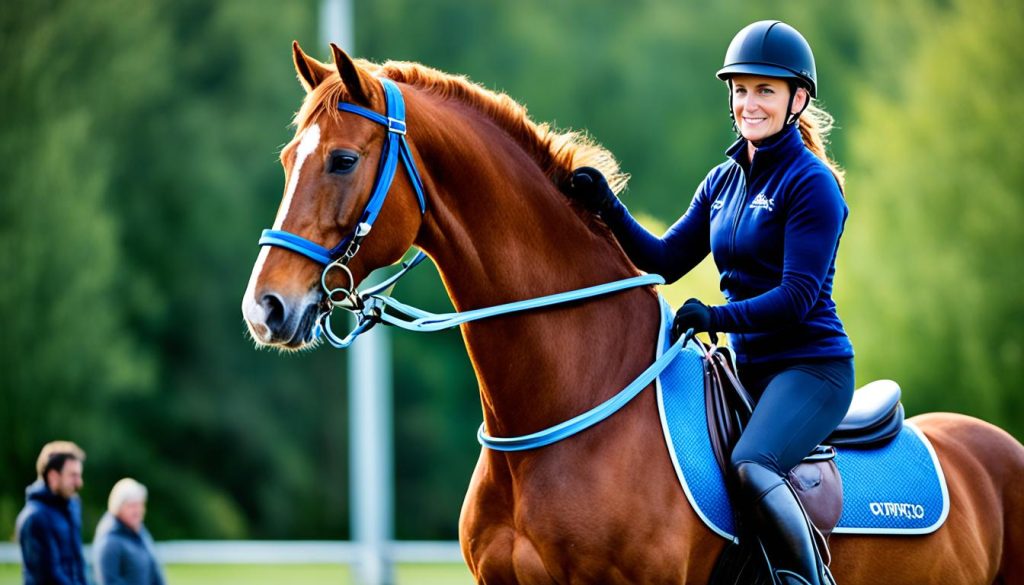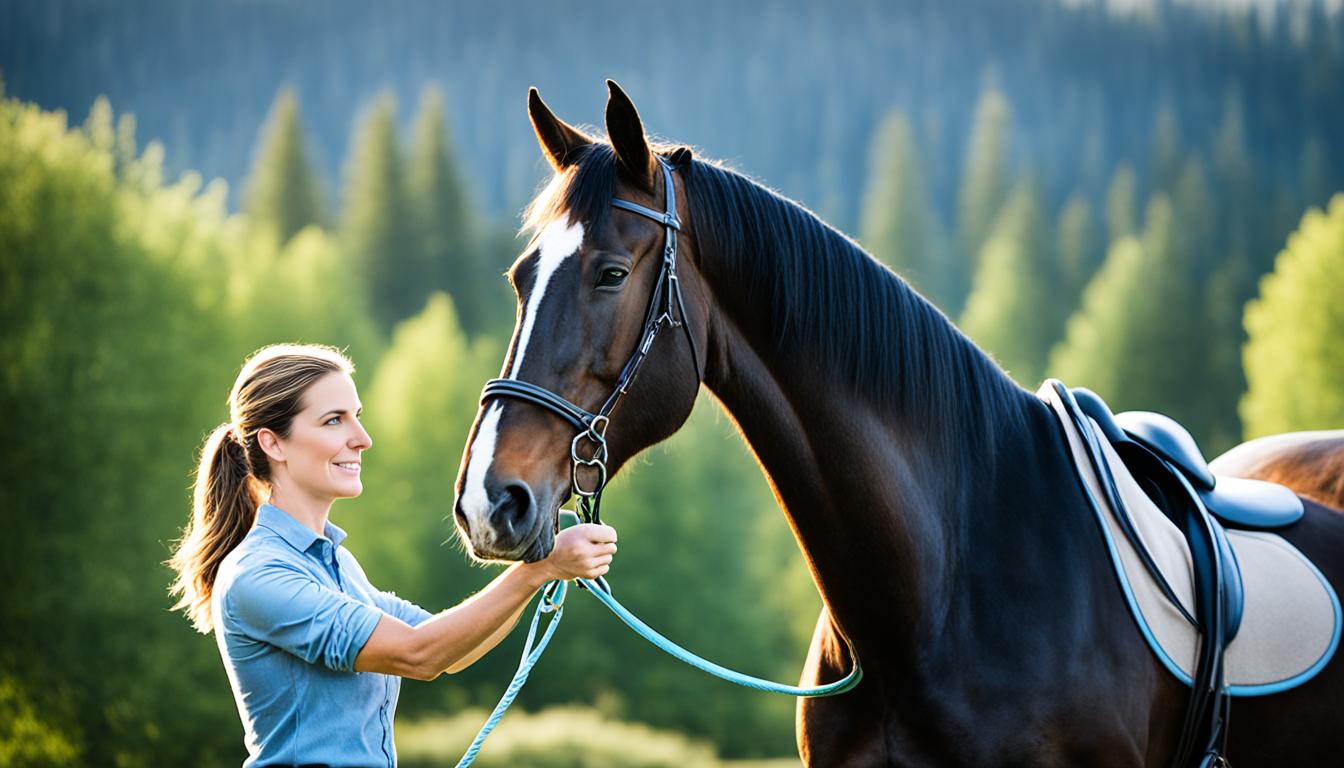“The essential joy of being with horses is that it brings us in contact with the rare elements of grace, beauty, spirit, and freedom.” – Sharon Ralls Lemon
Welcome to the world of liberty horse training, where the art of communication and freedom intertwine to create a remarkable bond between you and your horse. In this method, you will embark on a journey of understanding, trust, and mutual respect, allowing your horse to express its natural behaviors and instincts.
Liberty horse training is the practice of working with your horse without the use of tack or aids, relying solely on clear communication and a shared understanding. It is a technique that can be employed with horses of all ages, breeds, and disciplines, and offers a unique perspective on equine partnership.
Key Takeaways
- Liberty horse training fosters a deep connection and trust between you and your horse.
- It involves working without tack or aids, relying on clear communication and understanding.
- Observing your horse’s behavior and building a connection are essential starting points.
- Gradually introduce basic groundwork exercises before progressing to liberty work.
- Liberty horse training is open to beginners and can be done in a secure area such as a field.
As you delve into the world of liberty horse training, you will discover a path filled with grace, beauty, spirit, and freedom. Each moment spent with your horse will deepen the bond and bring you closer to unlocking the true potential within both of you.
What is Liberty Horse Training?
Liberty horse training is a unique approach to equine training that allows horses to express their natural instincts and behaviors while developing a deep connection with their trainer. Unlike traditional training methods that rely on tack and aids, liberty horse training takes place in a large riding arena or paddock where horses have the freedom to move around and make choices.
In liberty horse training, the trainer uses the horse’s natural instincts and behavior as the primary teaching tool. By understanding how horses communicate through body language, trainers can effectively communicate their cues and expectations. This method often incorporates natural horsemanship techniques that emphasize trust, respect, and partnership between horse and trainer.
Liberty horse training is a holistic approach that encompasses not only physical exercises but also mental and emotional engagement with the horse. It encourages horses to make choices, problem-solve, and think critically, ultimately leading to a stronger bond and a more willing partnership. By allowing horses to engage in their natural behaviors, liberty training methods create a positive and enjoyable experience for both horse and trainer.
Benefits of Liberty Horse Training
Liberty horse training offers several benefits for both horses and trainers:
- Enhanced Connection: By allowing horses to move freely and make choices, liberty training fosters a deeper bond and connection between horse and trainer.
- Improved Communication: By understanding and utilizing the horse’s body language, trainers can communicate more effectively and precisely.
- Increased Trust: Liberty training methods build trust between horse and trainer through positive reinforcement and clear communication.
- Greater Confidence: Horses that engage in liberty training often gain confidence in their abilities, leading to improved performance and a willingness to try new things.
By utilizing natural horsemanship techniques and allowing horses to express their natural behaviors, liberty horse training provides a holistic and effective approach to equine training. Whether you’re a beginner or an experienced rider, incorporating liberty training methods into your horsemanship can lead to a deeper connection and a more fulfilling partnership with your horse.
Testimonials
“Liberty horse training has completely transformed the way I interact with my horses. The freedom and trust that it creates are unparalleled. It’s a truly beautiful way to connect with these magnificent animals.” – Sarah Johnson, Equestrian Enthusiast
How to Start Liberty Horse Training
Starting liberty horse training is an exciting journey that begins with understanding natural horse behavior and establishing a strong connection with your equine partner. By learning to communicate effectively and using positive reinforcement, you can create a solid foundation for liberty horse training. Here are some essential steps to help you get started:
1. Observe and Connect: Spend time observing your horse and getting to know their personality. Watch how they interact with their environment and other horses. Building a connection based on trust and understanding is crucial for successful liberty horse training.
2. Speak Their Language: Learn to read your horse’s body language and cues. Horses communicate through subtle movements and expressions, and being able to interpret these signals will help you understand their needs and intentions. This will enable you to communicate more effectively during liberty training.
3. Positive Reinforcement: Use positive reinforcement methods to encourage desirable behaviors. Reward your horse with praise, treats, or scratches when they respond correctly to your cues. This will reinforce their understanding of what you’re asking and make the training experience enjoyable for them.
4. Groundwork Exercises: Begin with basic groundwork exercises using a halter and lead rope. These exercises help establish boundaries, respect, and responsiveness. Practice exercises such as leading, backing up, turning, stopping, and standing still. These exercises lay the foundation for liberty training and teach your horse to respond to your cues.
5. Gradual Transition to Liberty: Once your horse is comfortable with the groundwork exercises, gradually transition to working at liberty. Remove the lead rope and allow your horse to move freely around you. Start in a small enclosed area and gradually increase the size of the space as your horse becomes more confident. Remember to always prioritize safety and ensure you have a secure environment.
Starting liberty horse training requires patience, consistency, and a willingness to understand and communicate with your horse. By building a strong foundation and gradually increasing the complexity of exercises, you and your horse can develop an incredible bond and achieve remarkable results.

Testimonial from a Liberty Horse Trainer
“Starting liberty horse training was a transformative experience for both me and my horse. I learned to appreciate the power of trust, communication, and freedom. Through patient observation and positive reinforcement, my horse and I built a deep connection and unlocked a whole new level of partnership.”
| Benefits of Starting Liberty Horse Training | Liberty Horse Training Exercises |
|---|---|
| 1. Enhances trust and communication | 1. Teaching the horse to move away from pressure |
| 2. Develops a stronger bond with your horse | 2. Practicing walking shoulder to shoulder |
| 3. Improves your horsemanship skills | 3. Teaching the horse to stop and turn |
| 4. Allows your horse to express natural behaviors | 4. Introducing the horse to bow |
Starting liberty horse training can be an incredibly rewarding journey for both you and your horse. By following these steps and practicing various liberty horse training exercises, you can build a strong foundation and embark on an incredible partnership based on trust, respect, and freedom.
Liberty Horse Training for Beginners
If you’re new to horse training or just getting started with liberty training, you’re in the right place. Liberty horse training is a fantastic way for beginners to establish a strong foundation with their horse and build a trusting partnership. The best part? You don’t need any special equipment or facilities to begin.
Starting with liberty training from the beginning actually has its advantages. Unlike traditional training methods that may require unlearning old habits, beginners have a clean slate when it comes to liberty horse training. This allows you to develop a fresh approach and establish a solid connection with your horse without any preconceived notions.
When it comes to location, you can choose a secure area such as a field or paddock to practice liberty horse training. As long as the area is safe and free of obstacles, it provides the ideal space for your horse to move freely and express their natural behaviors.
As a beginner, take the time to observe your horse’s natural behaviors and get comfortable in their company. Building a strong partnership is all about understanding and mutual trust. Watch how they interact with their surroundings, other horses, and you as their trainer. This observation will help you connect at a deeper level and tailor your training to your horse’s individual needs.

Remember, liberty horse training is all about freedom of movement and choice. It’s essential to establish clear communication and set boundaries without the use of physical aids. As a beginner, focus on developing a deep understanding of your horse’s body language and cues. This will help you create a language of trust and respect that forms the foundation of liberty training.
In the next section, we’ll explore specific liberty horse training exercises that are perfect for beginners. These exercises will further enhance the bond between you and your horse and pave the way for a successful liberty horse training program.
Liberty Horse Training Exercises
When it comes to liberty horse training, there are various exercises you can incorporate into your training program to strengthen the bond and communication between you and your horse. These exercises focus on groundwork and allow your horse to express itself naturally, resulting in a rewarding and enjoyable experience for both of you.
Groundwork Exercises
Groundwork exercises form the foundation of liberty horse training. They help build trust, improve communication, and enhance the responsiveness of your horse. Here are some essential groundwork exercises you can practice:
- Teaching the horse to move away from pressure: This exercise helps establish respect and obedience. Use light pressure from your hand or a training stick to encourage your horse to move away.
- Walking shoulder to shoulder with the trainer: This exercise promotes teamwork and synchronization between you and your horse. Walk side by side with your horse, matching their pace and direction.
- Stopping and turning: Teach your horse to stop and turn on command. Use voice cues and body language to communicate your desired actions.
- Teaching the horse to bow: This advanced exercise strengthens the trust and connection with your horse. Start by rewarding any small bowing gestures and gradually shape them into a full bow.
By practicing these exercises consistently, you will not only improve your horse’s physical abilities but also create a deeper understanding and partnership with them.
Remember to start with the basics and gradually progress to more advanced exercises as your horse becomes more comfortable and responsive. Always prioritize your horse’s safety and well-being throughout the training process.
Next, let’s take a look at a practical example of how these exercises can be incorporated into a liberty horse training program.

A Sample Liberty Horse Training Program
Creating a structured training program can help you stay organized and keep track of your horse’s progress. Here’s a sample liberty horse training program:
| Week | Objectives | Exercises |
|---|---|---|
| 1 | Building trust and connection | – Teaching the horse to move away from pressure – Walking shoulder to shoulder – Introducing voice cues |
| 2 | Improving responsiveness | – Stopping and turning exercises – Reinforcing voice cues – Introducing body language cues |
| 3 | Advancing skills | – Refining stopping and turning exercises – Introducing bowing exercises – Progressing to off-leash work |
| 4 | Consolidating training | – Consolidating all exercises – Improving precision and timing – Increasing duration and complexity |
This sample program is flexible and can be adjusted based on your horse’s progress and individual needs. Remember to incorporate breaks and allow your horse to rest and relax between training sessions.
As you go through the program, take note of your horse’s reactions and adapt the exercises accordingly. Each horse is unique, and it’s important to tailor the training program to their abilities and temperaments.
By following a structured liberty horse training program and practicing a variety of groundwork exercises, you’ll create a solid foundation for your horse’s liberty training journey. Now that you have a better understanding of the exercises and program, you can confidently embark on your liberty horse training adventure!
Conclusion
Liberty horse training is a valuable tool for building trust and communication with your horse. By allowing them to move freely and make choices, you create a strong bond and connection. Incorporating natural horsemanship techniques, such as groundwork exercises, can lay a solid foundation for liberty training. Whether you are a beginner or experienced trainer, the principles of liberty training can be applied to enhance your horse training techniques.
Starting with basic groundwork exercises is a great way to introduce liberty training to your horse. As you progress, you will witness the development of a deeper connection and understanding between you and your equine partner. Through liberty training, you can unlock your horse’s true potential and achieve amazing results.
Embracing the principles of liberty training, such as allowing your horse to express themselves naturally, fosters a joyful and rewarding experience for both you and your horse. By dedicating time and effort to this method, you will witness remarkable changes in your horse’s behavior and responsiveness. So, get ready to embark on an exciting journey and explore the power of liberty horse training!
